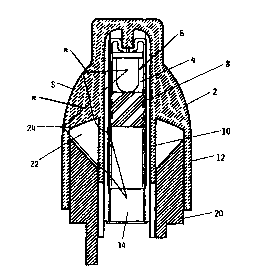Some of the information on this Web page has been provided by external sources. The Government of Canada is not responsible for the accuracy, reliability or currency of the information supplied by external sources. Users wishing to rely upon this information should consult directly with the source of the information. Content provided by external sources is not subject to official languages, privacy and accessibility requirements.
Any discrepancies in the text and image of the Claims and Abstract are due to differing posting times. Text of the Claims and Abstract are posted:
| (12) Patent Application: | (11) CA 2323868 |
|---|---|
| (54) English Title: | DEFROSTING DEVICE, IN PARTICULAR FOR REFRIGERATION SYSTEMS |
| (54) French Title: | DISPOSITIF DE DEGIVRAGE DESTINE PARTICULIEREMENT AUX SYSTEMES DE REFRIGERATION |
| Status: | Deemed Abandoned and Beyond the Period of Reinstatement - Pending Response to Notice of Disregarded Communication |
| (51) International Patent Classification (IPC): |
|
|---|---|
| (72) Inventors : |
|
| (73) Owners : |
|
| (71) Applicants : |
|
| (74) Agent: | ROBIC AGENCE PI S.E.C./ROBIC IP AGENCY LP |
| (74) Associate agent: | |
| (45) Issued: | |
| (86) PCT Filing Date: | 1999-02-25 |
| (87) Open to Public Inspection: | 1999-09-23 |
| Availability of licence: | N/A |
| Dedicated to the Public: | N/A |
| (25) Language of filing: | English |
| Patent Cooperation Treaty (PCT): | Yes |
|---|---|
| (86) PCT Filing Number: | PCT/EP1999/001227 |
| (87) International Publication Number: | WO 1999047870 |
| (85) National Entry: | 2000-09-12 |
| (30) Application Priority Data: | ||||||
|---|---|---|---|---|---|---|
|
A device for defrosting the finned cooling assembly (17) of a refrigeration
system, characterised by comprising: an ellipsoid (2, 26) of transparent
polymer materiel housing a light source (6, 32) positioned substantially in
correspondences with one of the focal points, and a sensor (12, 30) for the
light beam radiated by said source and reflected by the inner surface of the
ellipsoid, a plurality of heating and defrosting elements (18) for the finned
cooling assembly (17), which are activated by a signal emitted by the sensor
(12, 30) when this senses a variation in the luminous intensity of the beam,
said variation in luminous intensity of the beam being caused by the formation
of frost along the path of the light beam.
La présente invention concerne un dispositif de dégivrage de l'ensemble de refroidissement à ailette (17) d'un système de réfrigération, caractérisé en ce qu'il contient: (a) un ellipsoïde (2, 26) en matière polymère transparente contenant une source lumineuse (6, 32) placée sensiblement en correspondances avec un des points focaux, et un détecteur (12, 30) de faisceaux lumineux émis par ladite source et réfléchis sur la surface interne de l'ellipsoïde, (b) plusieurs éléments de chauffage et de dégivrage (18) conçus pour l'ensemble de refroidissement (17), qui sont activés par un signal émis par un détecteur (12, 30) lorsqu'il détecte une variation de l'intensité lumineuse d'un faisceau, provoquée par la formation de gel le long du trajet du faisceau lumineux.
Note: Claims are shown in the official language in which they were submitted.
Note: Descriptions are shown in the official language in which they were submitted.

2024-08-01:As part of the Next Generation Patents (NGP) transition, the Canadian Patents Database (CPD) now contains a more detailed Event History, which replicates the Event Log of our new back-office solution.
Please note that "Inactive:" events refers to events no longer in use in our new back-office solution.
For a clearer understanding of the status of the application/patent presented on this page, the site Disclaimer , as well as the definitions for Patent , Event History , Maintenance Fee and Payment History should be consulted.
| Description | Date |
|---|---|
| Application Not Reinstated by Deadline | 2005-02-25 |
| Time Limit for Reversal Expired | 2005-02-25 |
| Inactive: Abandon-RFE+Late fee unpaid-Correspondence sent | 2004-02-25 |
| Deemed Abandoned - Failure to Respond to Maintenance Fee Notice | 2004-02-25 |
| Letter Sent | 2001-04-27 |
| Inactive: Single transfer | 2001-03-23 |
| Inactive: Cover page published | 2000-12-08 |
| Inactive: First IPC assigned | 2000-12-06 |
| Inactive: Courtesy letter - Evidence | 2000-12-05 |
| Inactive: Notice - National entry - No RFE | 2000-11-30 |
| Application Received - PCT | 2000-11-28 |
| Application Published (Open to Public Inspection) | 1999-09-23 |
| Abandonment Date | Reason | Reinstatement Date |
|---|---|---|
| 2004-02-25 |
The last payment was received on 2002-12-16
Note : If the full payment has not been received on or before the date indicated, a further fee may be required which may be one of the following
Please refer to the CIPO Patent Fees web page to see all current fee amounts.
| Fee Type | Anniversary Year | Due Date | Paid Date |
|---|---|---|---|
| Basic national fee - small | 2000-09-12 | ||
| MF (application, 2nd anniv.) - small | 02 | 2001-02-26 | 2001-02-15 |
| Registration of a document | 2001-03-23 | ||
| MF (application, 3rd anniv.) - small | 03 | 2002-02-25 | 2002-02-12 |
| MF (application, 4th anniv.) - small | 04 | 2003-02-25 | 2002-12-16 |
Note: Records showing the ownership history in alphabetical order.
| Current Owners on Record |
|---|
| I.R.C.A. S.P.A. - INDUSTRIA RESISTENZE CORAZZATE E AFFINI |
| Past Owners on Record |
|---|
| ANTONIO FIORENTINI |
| MAURIZIO BURATTI |